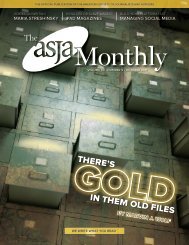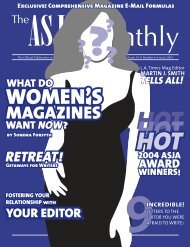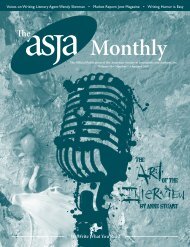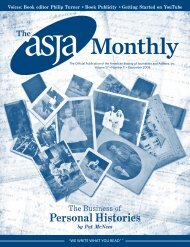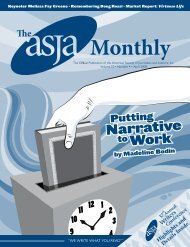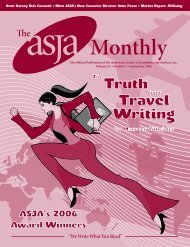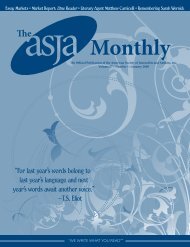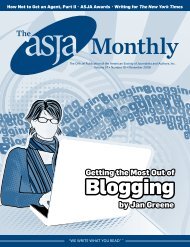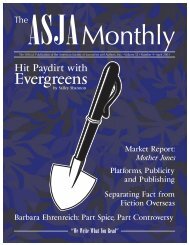Create successful ePaper yourself
Turn your PDF publications into a flip-book with our unique Google optimized e-Paper software.
What’s In Store<br />
Book Reviews by Melissa Gaskill<br />
Annoying: <strong>The</strong> Science of What Bugs Us, by Joe<br />
Palca and Flora Lichtman. John Wiley & Sons,<br />
<strong>2011</strong>, 262 pages, hardback. $25.95<br />
This book explores the science of what annoyance<br />
is and why things trigger it. Something<br />
remarkably similar to annoyance occurs<br />
across a broad spectrum of the animal kingdom,<br />
so it clearly serves some purpose, perhaps<br />
reminding us of what we should avoid<br />
to survive.<br />
Certain annoyances have to do with personal<br />
sensitivities. Others seem to transcend<br />
race, gender, age, and culture. One of the latter<br />
is overheard cell phone conversations—in part because unpredictability<br />
and annoying-ness correlate. With our brains trained<br />
to pay attention to dialogue, and to predict what comes next,<br />
hearing one side of a conversation is annoying. Palca, a science<br />
correspondent for National Public Radio, and Lichtman, multimedia<br />
editor for Science Friday, examine those things we find<br />
annoying, including sounds, smells, minor problems, change,<br />
and minor injustice.<br />
It isn’t possible to simply ignore something annoying; you<br />
have to focus on something else. Studies using fMRI (functional<br />
magnetic resonance imaging) show annoyance involves the part<br />
of the forebrain that serves as a gatekeeper between automatic<br />
processes and more conscious, fact-based ones. <strong>The</strong> brain chemical<br />
oxytocin also appears to play a role in annoyance, more evidence<br />
that annoyance played some protective function for our<br />
early ancestors—an irritant alarm of sorts.<br />
Journalists work with a wide variety of people and settings,<br />
offering plenty of opportunity to be annoyed. Research suggests<br />
that people have no idea when they’re annoying, so when<br />
faced with a client or interview subject who is, the burden falls<br />
on you to keep things civil and get through the encounter as well<br />
as you can. Will the knowledge that something is annoying help<br />
us overcome it Probably not, the authors conclude. Now that’s<br />
annoying.<br />
<strong>The</strong> Craft of Scientific Communication by Joseph<br />
E. Harmon and Alan G. Gross. <strong>The</strong> University of<br />
Chicago Press, 2010, 220 pages, paperback. $20.<br />
Scientists who write readable, understandable prose can<br />
help the rest of us better understand scientific papers to do our<br />
jobs better, too. <strong>The</strong> authors analyze the various parts of a scientific<br />
paper, beginning with the introduction, which contains a<br />
An independent journalist for 17 years, Melissa<br />
Gaskill writes about science and travel, primarily the<br />
outdoor, active kind. She’s an avid camper, hiker,<br />
kayaker, and scuba diver and is the author of Best<br />
Hikes with Dogs: Texas Hill Country and Gulf Coast<br />
(Mountaineers Books), now in its second printing.<br />
She’s currently working on a book about sea turtles.<br />
statement of the problem and the approach<br />
to solving it, and should tell readers up front<br />
why it matters that a scientist solved this<br />
particular problem.<br />
Abstracts, often the only part people<br />
read, tell what was done and how, and what<br />
was discovered. Good abstracts also persuade<br />
people to keep reading by telling them<br />
why this is important. Titles help scientists,<br />
and us, find relevant studies.<br />
Results and Discussion sections contain charts, tables,<br />
graphs and illustrations. Text generally includes comparisons to<br />
other work, and explanation of the qualifications and limitations<br />
of the current work. <strong>The</strong> Conclusion section is a good place to<br />
consider the “so what” question, and it sometimes includes anticipated<br />
or needed further study. <strong>The</strong> Methods section is essential<br />
because it tells us why we should believe the rest of the paper.<br />
<strong>The</strong> book also covers grant and proposal writing, writing<br />
for the public, giving scientific talks, as well as writing style and<br />
common pecadillos of science writing.<br />
Communicating scientific information is a long-standing<br />
tradition—since the 1600s, who knew—and still important today.<br />
Scientific papers are the first step in that process; the next<br />
steps are our responsibility as professional writers. If you write<br />
about science, this book may help you do it better.<br />
Sixty Candles: Reflections on the Writing Life, by<br />
members of the American Society of Journalists<br />
and Authors. iUniverse, 2008, 167 pages, paperback.<br />
$14.95<br />
This isn’t a new book, but it never received<br />
a review in our own journal. In this,<br />
my last review column, I right that egregious<br />
wrong.<br />
Sixty Candles contains short pieces contributed<br />
by <strong>ASJA</strong> members of all types and<br />
stripes (which, I must say, made reviewing<br />
this book a bit daunting!). <strong>The</strong> first two entries,<br />
from founding members, give a bit of<br />
insight into the origins of the organization.<br />
Topical chapters follow: in Becoming a Writer, members share<br />
their funny, touching, and tragic tales of early days. In Chapter<br />
2, <strong>The</strong> Writer’s Life, you’ll no doubt find a lot of common ground.<br />
Perhaps it’s Tim Harper’s exchange with a parent at a rec league:<br />
“My husband would love to help coach, but he works.” Tim: “I<br />
work, too.” Parent: “Oh...somebody told me you were a writer.” Or<br />
maybe the advice of a fellow writer to Cindy La Ferle: If you’re not<br />
getting rejection slips, you’re not aiming high enough or sending<br />
out enough material. (Yeah, that’s it! I’m aiming high!) Or,<br />
Linda Eve Diamond’s favorite question: “Are you a real writer”<br />
Chapter 4, Telling Stories, chronicles the ups, downs, and weird<br />
in-betweens of this profession/calling/art. At least one is bound<br />
to be stranger than yours. You’ll find practical stuff in Chapter 5,<br />
Seasoned Advice—get organized, don’t listen to negative voices,<br />
18 THE <strong>ASJA</strong> MONTHLY DECEMBER <strong>2011</strong> WWW.<strong>ASJA</strong>.ORG





